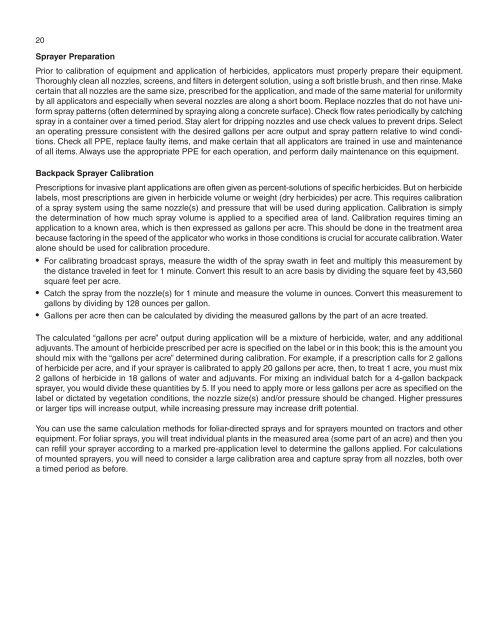A Management Guide for Invasive Plants in Southern Forests James ...
A Management Guide for Invasive Plants in Southern Forests James ...
A Management Guide for Invasive Plants in Southern Forests James ...
- No tags were found...
Create successful ePaper yourself
Turn your PDF publications into a flip-book with our unique Google optimized e-Paper software.
20Sprayer PreparationPrior to calibration of equipment and application of herbicides, applicators must properly prepare their equipment.Thoroughly clean all nozzles, screens, and filters <strong>in</strong> detergent solution, us<strong>in</strong>g a soft bristle brush, and then r<strong>in</strong>se. Makecerta<strong>in</strong> that all nozzles are the same size, prescribed <strong>for</strong> the application, and made of the same material <strong>for</strong> uni<strong>for</strong>mityby all applicators and especially when several nozzles are along a short boom. Replace nozzles that do not have uni<strong>for</strong>mspray patterns (often determ<strong>in</strong>ed by spray<strong>in</strong>g along a concrete surface). Check flow rates periodically by catch<strong>in</strong>gspray <strong>in</strong> a conta<strong>in</strong>er over a timed period. Stay alert <strong>for</strong> dripp<strong>in</strong>g nozzles and use check values to prevent drips. Selectan operat<strong>in</strong>g pressure consistent with the desired gallons per acre output and spray pattern relative to w<strong>in</strong>d conditions.Check all PPE, replace faulty items, and make certa<strong>in</strong> that all applicators are tra<strong>in</strong>ed <strong>in</strong> use and ma<strong>in</strong>tenanceof all items. Always use the appropriate PPE <strong>for</strong> each operation, and per<strong>for</strong>m daily ma<strong>in</strong>tenance on this equipment.Backpack Sprayer CalibrationPrescriptions <strong>for</strong> <strong>in</strong>vasive plant applications are often given as percent-solutions of specific herbicides. But on herbicidelabels, most prescriptions are given <strong>in</strong> herbicide volume or weight (dry herbicides) per acre. This requires calibrationof a spray system us<strong>in</strong>g the same nozzle(s) and pressure that will be used dur<strong>in</strong>g application. Calibration is simplythe determ<strong>in</strong>ation of how much spray volume is applied to a specified area of land. Calibration requires tim<strong>in</strong>g anapplication to a known area, which is then expressed as gallons per acre. This should be done <strong>in</strong> the treatment areabecause factor<strong>in</strong>g <strong>in</strong> the speed of the applicator who works <strong>in</strong> those conditions is crucial <strong>for</strong> accurate calibration. Wateralone should be used <strong>for</strong> calibration procedure.• For calibrat<strong>in</strong>g broadcast sprays, measure the width of the spray swath <strong>in</strong> feet and multiply this measurement bythe distance traveled <strong>in</strong> feet <strong>for</strong> 1 m<strong>in</strong>ute. Convert this result to an acre basis by divid<strong>in</strong>g the square feet by 43,560square feet per acre.• Catch the spray from the nozzle(s) <strong>for</strong> 1 m<strong>in</strong>ute and measure the volume <strong>in</strong> ounces. Convert this measurement togallons by divid<strong>in</strong>g by 128 ounces per gallon.• Gallons per acre then can be calculated by divid<strong>in</strong>g the measured gallons by the part of an acre treated.The calculated “gallons per acre” output dur<strong>in</strong>g application will be a mixture of herbicide, water, and any additionaladjuvants. The amount of herbicide prescribed per acre is specified on the label or <strong>in</strong> this book; this is the amount youshould mix with the “gallons per acre” determ<strong>in</strong>ed dur<strong>in</strong>g calibration. For example, if a prescription calls <strong>for</strong> 2 gallonsof herbicide per acre, and if your sprayer is calibrated to apply 20 gallons per acre, then, to treat 1 acre, you must mix2 gallons of herbicide <strong>in</strong> 18 gallons of water and adjuvants. For mix<strong>in</strong>g an <strong>in</strong>dividual batch <strong>for</strong> a 4-gallon backpacksprayer, you would divide these quantities by 5. If you need to apply more or less gallons per acre as specified on thelabel or dictated by vegetation conditions, the nozzle size(s) and/or pressure should be changed. Higher pressuresor larger tips will <strong>in</strong>crease output, while <strong>in</strong>creas<strong>in</strong>g pressure may <strong>in</strong>crease drift potential.You can use the same calculation methods <strong>for</strong> foliar-directed sprays and <strong>for</strong> sprayers mounted on tractors and otherequipment. For foliar sprays, you will treat <strong>in</strong>dividual plants <strong>in</strong> the measured area (some part of an acre) and then youcan refill your sprayer accord<strong>in</strong>g to a marked pre-application level to determ<strong>in</strong>e the gallons applied. For calculationsof mounted sprayers, you will need to consider a large calibration area and capture spray from all nozzles, both overa timed period as be<strong>for</strong>e.
















